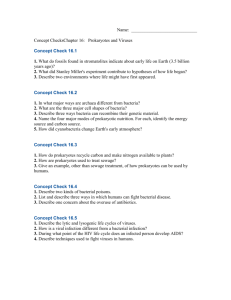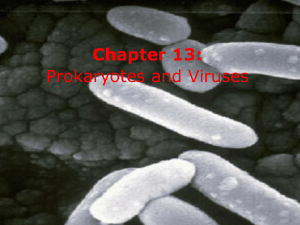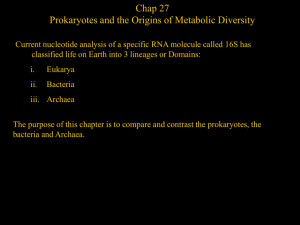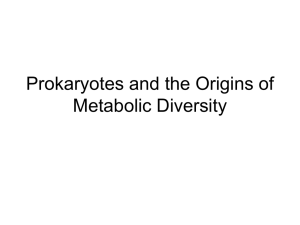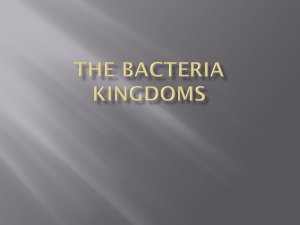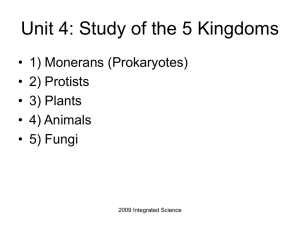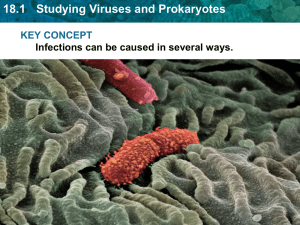Prokaryotes and Viruses
advertisement
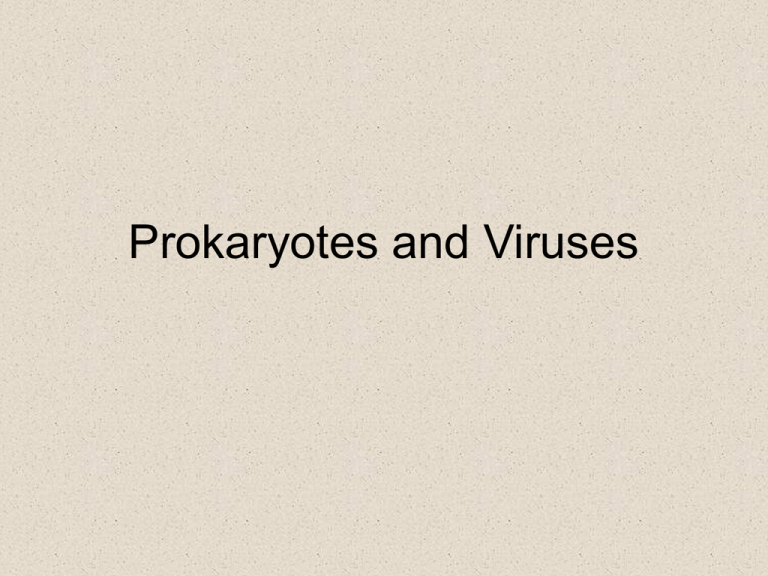
Prokaryotes and Viruses Prokaryotes: The Simplest Organisms • prokaryotes have been plentiful on earth for over 2.5 billion years • prokaryotes today are the simplest and most abundant form of life on earth • prokaryotes occupy an important place in the web of life on earth they play a key role in cycling minerals within the earth’s ecosystems photosynthetic bacteria were largely responsible for introducing oxygen into the earth’s atmosphere bacteria are responsible for some of the most deadly animal and plant diseases, including many human diseases Prokaryotes: The Simplest Organisms • prokaryotes are small and simply organized they are single-celled and lack a nucleus their single circle of DNA is not confined by a nuclear membrane both bacteria and archaea are prokaryotes Prokaryotes:The Simplest Organisms • the plasma membrane of bacteria is encased within a cell wall of peptidoglycan in some bacteria, the peptidoglycan layer is thin and covered over by an outer membrane of lipopolysaccharide (LPS) • bacteria who have this layer (LPS) are gram-negative • bacteria who lack this layer (LPS) are gram-positive The structures of bacterial cell walls. The Simplest Organisms • outside the cell wall and membrane, many bacteria have a gelatinous layer called a capsule • many kinds of bacteria have long, threadlike outgrowths, called flagella, that are used in swimming • some bacteria also possess shorter outgrowths, called pili (singular, pilus) that help the cell to attach to surfaces or other cells Prokaryotes: The Simplest Organisms • prokaryotes reproduce by binary fission the cell simply increases in size and divides in two * View binary fission in my Website (video clip) • some bacteria can exchange genetic information by passing plasmids (small circular DNA) from one cell to another this process is called conjugation a pilus acts as a conjugation bridge between a donor cell and a recipient cell Bacterial Conjugation • Refer to my Website to view conjugation (animation) Contact by a pilus. Bacterial Shapes • Refer to my Website to view the three types of bacterial shapes PP • Coccus (singular) – Cocci (plural)- spheres • Bacillus (singular) – Bacilli (plural)- rods • Spirillum (singular)-Spirilla (plural)- spirals Comparing Prokaryotes to Eukaryotes • prokaryotes are far more metabolically diverse than eukaryotes prokaryotes have evolved many more ways than eukaryotes to acquire the carbon atoms and energy necessary for growth and reproduction many are autotrophs, organisms that obtain their carbon from inorganic CO2 others are heterotrophs, organisms that obtain at least some of their carbon from organic molecules Importance of Prokaryotes • prokaryotes affect our lives today in many important ways prokaryotes and the environment bacteria and genetic engineering bacteria, disease, and bioterrorism Using bacteria to clean up oil spills. The Structure of Viruses • viruses do not satisfy all of the criteria for being considered “alive” because they possess only a portion of the properties of living organisms viruses are literally segments of DNA (or sometimes RNA) wrapped in a protein coat they cannot reproduce on their own The Structure of Viruses • viruses are extremely small, with most detectable only through the use of an electron microscope Wendell Stanley in 1935 discovered the structure of tobacco mosaic virus (TMV) • TMV is a mixture of RNA and protein most viruses, like TMV, form a protein sheath, or capsid, around a nucleic acid core • many viruses form a membranelike envelope around the capsid The structure of bacterial, plant, and animal viruses. How Bacteriophages Enter Prokaryotic Cells • bacteriophages are viruses that infect bacteria there is a large diversity among these viruses in terms of shapes and amounts of DNA and proteins when the virus kills the infected host in which it is replicating, this is called a lytic cycle at other times the virus integrates itself into the host genome but does not replicate • this is called the lysogenic cycle • while residing in the host in this fashion, the virus is called a prophage A T4 bacteriophage. Lytic and lysogenic cycles of a bacteriophage. • View the life cycle of bacteriophages – animation in my Website

